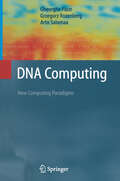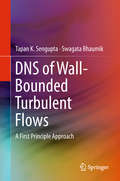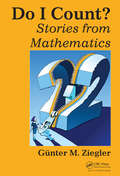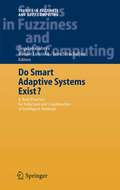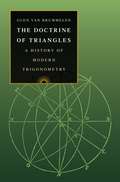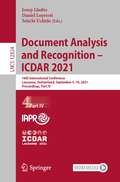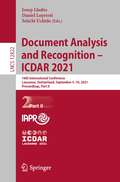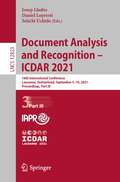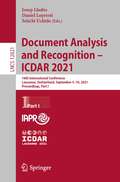- Table View
- List View
DLP and Extensions: An Optimization Model and Decision Support System
by John L. NazarethDLP denotes a dynamic-linear modeling and optimization approach to computational decision support for resource planning problems that arise, typically, within the natural resource sciences and the disciplines of operations research and operational engineering. The text examines the techniques of dynamic programming (DP) and linear programming (LP). DLP also connotes a broad modeling/algorithmic concept that has numerous areas of application. Two motivating examples provide a linking thread through the main chapters. The appendix provides a demonstration program, executable on a PC, for hands-on experience with the DLP approach.
DNA — Technology and Its Forensic Application
by M. Staak C. Rittner B. Brinkmann G. BerghausAll up-to-date aspects of DNA technology are discussed partly in review lectures but mostly in research articles in this volume: new methods, population statistics for different restriction fragment length polymorphisms (RFLP's), new developments dealing with the polymerase chain reaction (PCR), biostatistical aspects of single locus and multi locus profiles as well as examples of practical applications in paternity testing and forensic stain analysis. Contributors to this volume include most internationally acclaimed researchers in this field. Besides facts that are primarily of interest to forensic scientists, immunohaematologists and human geneticists should also find some aspects for their research.
DNA Computing: 9th International Workshop on DNA Based Computers, DNA9, Madison, WI, USA, June 1-3, 2003, revised Papers (Lecture Notes in Computer Science #2943)
by Junghuei Chen John ReifDNA Computing: 6th International Workshop on DNA-Based Computers, DNA 2000, Leiden, The Netherlands, June 13-17, 2000. Revised Papers (Lecture Notes in Computer Science #2054)
by Anne Condon Grzegorz RozenbergThe papers in this volume were presented at the 6th International Meeting on DNA Based Computers, organized by the Leiden Center for Natural Computing and held from June 13 to June 17, 2000 at The Lorentz Center, University of Leiden, Leiden, The Netherlands. DNA Computing is a novel and fascinating development at the interface of computer science and molecular biology. It has emerged in recent years, not simply as an exciting technology for information processing, but also as a catalyst for knowledge transfer between information processing, nanotechnology, and biology. This area of research has the potential to change our understanding of the theory and practice of computing. The call for papers and poster presentations sought contributions of original research and technical expositions in all areas of bio-computation. A total of 33 abstracts were submitted of which 16 were accepted for presentation and included in the proceedings. The papers were selected by the program committee based on originality and quality of research and on relevance to the bio-computing eld. Invited talks were given by Masami Hagiya (Tokyo University), Laura La- weber (Princeton University), John Reif (Duke University), Thomas Schmidt (Leiden University), and Lloyd M. Smith (University of Wisconsin). Invited - pers based on the talks by Hagiya and Reif are included in this volume, along with the contributed papers. Additional tutorials were held on the rst and last days of the conference.
DNA Computing: 8th International Workshop on DNA Based Computers, DNA8, Sapporo, Japan, June 10-13, 2002, Revised Papers (Lecture Notes in Computer Science #2568)
by Masami Hagiya Azuma OhuchiBiomolecular computing has emerged as an interdisciplinary ?eld that draws - gether chemistry, computer science, mathematics, molecular biology, and physics. Our knowledge on DNA nanotechnology and biomolecular computing increases exponentially with every passing year. The international meeting on DNA Based Computers has been a forum where scientists with di?erent backgrounds, yet sharing a common interest in biomolecular computing, meet and present their latest results. Continuing this tradition, the 8th International Meeting on DNA Based Computers (DNA8) focuses on the current theoretical and experimental results with the greatest impact. Papers and poster presentations were sought in all areas that relate to b- molecular computing, including (but not restricted to): algorithms and appli- tions, analysis of laboratory techniques/theoretical models, computational p- cesses in vitro and in vivo, DNA-computing-based biotechnological applications, DNA devices, error evaluation and correction, in vitro evolution, models of biomolecular computing (using DNA and/or other molecules), molecular - sign, nucleic acid chemistry, and simulation tools. Papers and posters with new experimental results were particularly encouraged. Authors who wished their work to be considered for either oral or poster presentation were asked to select from one of two submission “tracks”: – Track A - Full Paper – Track B - One-Page Abstract For authors with late-breaking results, or who were submitting their manuscript to a scienti?c journal, a one-page abstract, rather than a full paper, could be submitted in Track B. Authors could (optionally) include a preprint of their full paper, for consideration only by the program committee.
DNA Computing: 7th International Workshop on DNA-Based Computers, DNA7, Tampa, FL, USA, June 10-13, 2001, Revised Papers (Lecture Notes in Computer Science #2340)
by Natasa Jonoska Nadriaan C. SeemanDNA Computing: New Computing Paradigms (Texts in Theoretical Computer Science. An EATCS Series)
by Gheorghe Paun Grzegorz Rozenberg Arto SalomaaThis is the first book on DNA computing, a molecular approach that may revolutionize computing-replacing silicon with carbon and microchips with DNA molecules. The book starts with an introduction to DNA computing, exploring the power of complementarity, the basics of biochemistry, and language and computation theory. It then brings the reader to the most advanced theories develop thus far in this emerging research area.
DNA Computing and Molecular Programming: 23rd International Conference, DNA 23, Austin, TX, USA, September 24–28, 2017, Proceedings (Lecture Notes in Computer Science #10467)
by Robert Brijder and Lulu QianThis book constitutes the refereed proceedings of the 23th International Conference on DNA Computing and Molecular Programming, DNA 23, held Austin, TX, USA, in September 2017. The 16 full papers presented were carefully selected from 23 submissions. Research in DNA computing aims to draw together mathematics, computerscience, physics, chemistry, biology, and nanotechnology to address the analysis, design, and synthesis of information-based molecular systems. The papers address all areas related to biomolecular computing such as: algorithms and models for computation with biomolecular systems; computational processes in vitro and in vivo; molecular motors and molecular robotics; studies of fault-tolerance and error correction; software tools for analysis, simulation, and design; synthetic biology and in vitro evolution; applications in engineering, physics, chemistry, biology, and medicine.
DNA Methylation Microarrays: Experimental Design and Statistical Analysis
by Sun-Chong Wang Art PetronisProviding an interface between dry-bench bioinformaticians and wet-lab biologists, DNA Methylation Microarrays: Experimental Design and Statistical Analysis presents the statistical methods and tools to analyze high-throughput epigenomic data, in particular, DNA methylation microarray data. Since these microarrays share the same under
DNS of Wall-Bounded Turbulent Flows: A First Principle Approach
by Tapan K. Sengupta Swagata BhaumikThis book highlights by careful documentation of developments what led to tracking the growth of deterministic disturbances inside the shear layer from receptivity to fully developed turbulent flow stages. Associated theoretical and numerical developments are addressed from basic level so that an uninitiated reader can also follow the materials which lead to the solution of a long-standing problem. Solving Navier-Stokes equation by direct numerical simulation (DNS) from the first principle has been considered as one of the most challenging problems of understanding what causes transition to turbulence. Therefore, this book is a very useful addition to advanced CFD and advanced fluid mechanics courses.
DNA Systems Under Internal and External Forcing: An Exploration Using Coarse-Grained Modelling (Springer Theses)
by Megan Clare EngelThe interactions of DNA with force are central to manifold fields of inquiry, including the de novo design of DNA nanostructures, the use of DNA to probe the principles of biological self-assembly, and the operation of cellular nanomachines. This work presents a survey of three distinct ways coarse-grained simulations can help characterize these interactions. A non-equilibrium energy landscape reconstruction technique is validated for use with the oxDNA model and a practical framework to guide future applications is established. A novel method for calculating entropic forces in DNA molecules is outlined and contrasted with existing, flawed approaches. Finally, a joint experimental-simulation study of large DNA origami nanostructures under force sheds light on design principles and, through vivid illustrations, their unfolding process. This text provides an accessible and exciting launching point for any student interested in the computational study of DNA mechanics and force interactions.
Do Androids Dream of Symmetric Sheaves?: And Other Mathematically Bent Stories
by Colin AdamsWhy is the Devil thrilled when Hell gets its first mathematician? How do 6 and 27 solve the diabolical murder of 9? What are the advantages a vampire has in the math world? What happens when we run out of new math to discover? How does Dr. Frankenstein create the ideal mathematical creature? What transpires when a grad student digging for theorems strikes a rich vein on the ridge overlooking Deadwood? What happens when math students band together to foment rebellion? What will a mathematician do beyond the grave to finish that elusive proof?This is just a small subset of the questions plumbed in this collection of 45 mathematically bent stories from the fertile imagination of Colin Adams. Originally appearing in The Mathematical Intelligencer, an expository mathematics magazine, these tales give a decidedly unconventional look at the world of mathematics and mathematicians. A section of notes is provided at the end of the book that explain references that may not be familiar to all and that include additional commentary by the author.
Do Colors Exist?: And Other Profound Physics Questions
by Seth Stannard CottrellWhy do polished stones look wet? How does the Twin Paradox work? What if Jupiter were a star? How can we be sure that pi never repeats? How does a quantum computer break encryption? Discover the answers to these, and other profound physics questions! This fascinating book presents a collection of articles based on conversations and correspondences between the author and complete strangers about physics and math. The author, a researcher in mathematical physics, responds to dozens of questions posed by inquiring minds from all over the world, ranging from the everyday to the profound. Rather than unnecessarily complex explanations mired in mysterious terminology and symbols, the reader is presented with the reasoning, experiments, and mathematics in a casual, conversational, and often comical style. Neither over-simplified nor over-technical, the lucid and entertaining writing will guide the reader from each innocent question to a better understanding of the weird and beautiful universe around us. Advance praise for Do Colors Exist?: “Every high school science teacher should have a copy of this book. The individual articles offer enrichment to those students who wish to go beyond a typical ‘dry curriculum’. The articles are very fun. I probably laughed out loud every 2-3 minutes. This is not easy to do. In fact, my children are interested in the book because they heard me laughing so much.” – Ken Ono, Emory University
Do I Count?: Stories from Mathematics
by Gunter M. ZieglerThe subject of mathematics is not something distant, strange, and abstract that you can only learn about-and often dislike-in school. It is in everyday situations, such as housekeeping, communications, traffic, and weather reports. Taking you on a trip into the world of mathematics, Do I Count? Stories from Mathematics describes in a clear and capt
Do Not Erase: Mathematicians and Their Chalkboards
by Jessica WynneA photographic exploration of mathematicians’ chalkboards“A mathematician, like a painter or poet, is a maker of patterns,” wrote the British mathematician G. H. Hardy. In Do Not Erase, photographer Jessica Wynne presents remarkable examples of this idea through images of mathematicians’ chalkboards. While other fields have replaced chalkboards with whiteboards and digital presentations, mathematicians remain loyal to chalk for puzzling out their ideas and communicating their research. Wynne offers more than one hundred stunning photographs of these chalkboards, gathered from a diverse group of mathematicians around the world. The photographs are accompanied by essays from each mathematician, reflecting on their work and processes. Together, pictures and words provide an illuminating meditation on the unique relationships among mathematics, art, and creativity.The mathematicians featured in this collection comprise exciting new voices alongside established figures, including Sun-Yung Alice Chang, Alain Connes, Misha Gromov, Andre Neves, Kasso Okoudjou, Peter Shor, Christina Sormani, Terence Tao, Claire Voisin, and many others. The companion essays give insights into how the chalkboard serves as a special medium for mathematical expression. The volume also includes an introduction by the author, an afterword by New Yorker writer Alec Wilkinson, and biographical information for each contributor.Do Not Erase is a testament to the myriad ways that mathematicians use their chalkboards to reveal the conceptual and visual beauty of their discipline—shapes, figures, formulas, and conjectures created through imagination, argument, and speculation.
Do Not Erase: Mathematicians and Their Chalkboards
by Jessica WynneA photographic exploration of mathematicians’ chalkboards“A mathematician, like a painter or poet, is a maker of patterns,” wrote the British mathematician G. H. Hardy. In Do Not Erase, photographer Jessica Wynne presents remarkable examples of this idea through images of mathematicians’ chalkboards. While other fields have replaced chalkboards with whiteboards and digital presentations, mathematicians remain loyal to chalk for puzzling out their ideas and communicating their research. Wynne offers more than one hundred stunning photographs of these chalkboards, gathered from a diverse group of mathematicians around the world. The photographs are accompanied by essays from each mathematician, reflecting on their work and processes. Together, pictures and words provide an illuminating meditation on the unique relationships among mathematics, art, and creativity.The mathematicians featured in this collection comprise exciting new voices alongside established figures, including Sun-Yung Alice Chang, Alain Connes, Misha Gromov, Andre Neves, Kasso Okoudjou, Peter Shor, Christina Sormani, Terence Tao, Claire Voisin, and many others. The companion essays give insights into how the chalkboard serves as a special medium for mathematical expression. The volume also includes an introduction by the author, an afterword by New Yorker writer Alec Wilkinson, and biographical information for each contributor.Do Not Erase is a testament to the myriad ways that mathematicians use their chalkboards to reveal the conceptual and visual beauty of their discipline—shapes, figures, formulas, and conjectures created through imagination, argument, and speculation.
Do Plants Know Math?: Unwinding the Story of Plant Spirals, from Leonardo da Vinci to Now
by Stéphane Douady Jacques Dumais Christophe Golé Nancy PickA breathtakingly illustrated look at botanical spirals and the scientists who puzzled over themCharles Darwin was driven to distraction by plant spirals, growing so exasperated that he once begged a friend to explain the mystery &“if you wish to save me from a miserable death.&” The legendary naturalist was hardly alone in feeling tormented by these patterns. Plant spirals captured the gaze of Leonardo da Vinci and became Alan Turing&’s final obsession. This book tells the stories of the physicists, mathematicians, and biologists who found themselves magnetically drawn to Fibonacci spirals in plants, seeking an answer to why these beautiful and seductive patterns occur in botanical forms as diverse as pine cones, cabbages, and sunflowers.Do Plants Know Math? takes you down through the centuries to explore how great minds have been captivated and mystified by Fibonacci patterns in nature. It presents a powerful new geometrical solution, little known outside of scientific circles, that sheds light on why regular and irregular spiral patterns occur. Along the way, the book discusses related plant geometries such as fractals and the fascinating way that leaves are folded inside of buds. Your neurons will crackle as you begin to see the connections. This book will inspire you to look at botanical patterns—and the natural world itself—with new eyes.Featuring hundreds of gorgeous color images, Do Plants Know Math? includes a dozen creative hands-on activities and even spiral-plant recipes, encouraging readers to explore and celebrate these beguiling patterns for themselves.
Do Plants Know Math?: Unwinding the Story of Plant Spirals, from Leonardo da Vinci to Now
by Stéphane Douady Jacques Dumais Christophe Golé Nancy PickA breathtakingly illustrated look at botanical spirals and the scientists who puzzled over themCharles Darwin was driven to distraction by plant spirals, growing so exasperated that he once begged a friend to explain the mystery &“if you wish to save me from a miserable death.&” The legendary naturalist was hardly alone in feeling tormented by these patterns. Plant spirals captured the gaze of Leonardo da Vinci and became Alan Turing&’s final obsession. This book tells the stories of the physicists, mathematicians, and biologists who found themselves magnetically drawn to Fibonacci spirals in plants, seeking an answer to why these beautiful and seductive patterns occur in botanical forms as diverse as pine cones, cabbages, and sunflowers.Do Plants Know Math? takes you down through the centuries to explore how great minds have been captivated and mystified by Fibonacci patterns in nature. It presents a powerful new geometrical solution, little known outside of scientific circles, that sheds light on why regular and irregular spiral patterns occur. Along the way, the book discusses related plant geometries such as fractals and the fascinating way that leaves are folded inside of buds. Your neurons will crackle as you begin to see the connections. This book will inspire you to look at botanical patterns—and the natural world itself—with new eyes.Featuring hundreds of gorgeous color images, Do Plants Know Math? includes a dozen creative hands-on activities and even spiral-plant recipes, encouraging readers to explore and celebrate these beguiling patterns for themselves.
Do Smart Adaptive Systems Exist?: Best Practice for Selection and Combination of Intelligent Methods (Studies in Fuzziness and Soft Computing #173)
by Bogdan Gabrys Kauko Leiviskä Jens StrackeljanDo Smart Adaptive Systems Exist? is intended as a reference and a guide summarising and focusing on best practices when using intelligent techniques and building systems requiring a degree of adaptation and intelligence. It is therefore not intended as a collection of the most recent research results, but as a practical guide for experts from other areas and industrial users interested in building solutions to their problems using intelligent techniques. One of the main issues covered is an attempt to answer the question of how to select and/or combine suitable intelligent techniques from a large pool of potential solutions. Another attractive feature of the book is that it brings together experts from neural network, fuzzy, machine learning, evolutionary and hybrid systems communities who will provide their views on how these different intelligent technologies have contributed and will contribute to creation of smart adaptive systems of the future.
The Doctrine of Chances: Probabilistic Aspects of Gambling (Probability and Its Applications)
by Stewart N. EthierThe Doctrine of Triangles: A History of Modern Trigonometry
by Glen Van BrummelenAn interdisciplinary history of trigonometry from the mid-sixteenth century to the early twentiethThe Doctrine of Triangles offers an interdisciplinary history of trigonometry that spans four centuries, starting in 1550 and concluding in the 1900s. Glen Van Brummelen tells the story of trigonometry as it evolved from an instrument for understanding the heavens to a practical tool, used in fields such as surveying and navigation. In Europe, China, and America, trigonometry aided and was itself transformed by concurrent mathematical revolutions, as well as the rise of science and technology.Following its uses in mid-sixteenth-century Europe as the "foot of the ladder to the stars" and the mathematical helpmate of astronomy, trigonometry became a ubiquitous tool for modeling various phenomena, including animal populations and sound waves. In the late sixteenth century, trigonometry increasingly entered the physical world through the practical disciplines, and its societal reach expanded with the invention of logarithms. Calculus shifted mathematical reasoning from geometric to algebraic patterns of thought, and trigonometry’s participation in this new mathematical analysis grew, encouraging such innovations as complex numbers and non-Euclidean geometry. Meanwhile in China, trigonometry was evolving rapidly too, sometimes merging with indigenous forms of knowledge, and with Western discoveries. In the nineteenth century, trigonometry became even more integral to science and industry as a fundamental part of the science and engineering toolbox, and a staple subject in high school classrooms.A masterful combination of scholarly rigor and compelling narrative, The Doctrine of Triangles brings trigonometry’s rich historical past full circle into the modern era.
Document Analysis and Recognition – ICDAR 2021: 16th International Conference, Lausanne, Switzerland, September 5–10, 2021, Proceedings, Part IV (Lecture Notes in Computer Science #12824)
by Josep Lladós Daniel Lopresti Seiichi UchidaThis four-volume set of LNCS 12821, LNCS 12822, LNCS 12823 and LNCS 12824, constitutes the refereed proceedings of the 16th International Conference on Document Analysis and Recognition, ICDAR 2021, held in Lausanne, Switzerland in September 2021. The 182 full papers were carefully reviewed and selected from 340 submissions, and are presented with 13 competition reports.The papers are organized into the following topical sections: scene text detection and recognition, document classification, gold-standard benchmarks and data sets, historical document analysis, and handwriting recognition. In addition, the volume contains results of 13 scientific competitions held during ICDAR 2021.
Document Analysis and Recognition – ICDAR 2021: 16th International Conference, Lausanne, Switzerland, September 5–10, 2021, Proceedings, Part II (Lecture Notes in Computer Science #12822)
by Josep Lladós Daniel Lopresti Seiichi UchidaThis four-volume set of LNCS 12821, LNCS 12822, LNCS 12823 and LNCS 12824, constitutes the refereed proceedings of the 16th International Conference on Document Analysis and Recognition, ICDAR 2021, held in Lausanne, Switzerland in September 2021. The 182 full papers were carefully reviewed and selected from 340 submissions, and are presented with 13 competition reports.The papers are organized into the following topical sections: document analysis for literature search, document summarization and translation, multimedia document analysis, mobile text recognition, document analysis for social good, indexing and retrieval of documents, physical and logical layout analysis, recognition of tables and formulas, and natural language processing (NLP) for document understanding.
Document Analysis and Recognition – ICDAR 2021: 16th International Conference, Lausanne, Switzerland, September 5–10, 2021, Proceedings, Part III (Lecture Notes in Computer Science #12823)
by Josep Lladós Daniel Lopresti Seiichi UchidaThis four-volume set of LNCS 12821, LNCS 12822, LNCS 12823 and LNCS 12824, constitutes the refereed proceedings of the 16th International Conference on Document Analysis and Recognition, ICDAR 2021, held in Lausanne, Switzerland in September 2021. The 182 full papers were carefully reviewed and selected from 340 submissions, and are presented with 13 competition reports.The papers are organized into the following topical sections: extracting document semantics, text and symbol recognition, document analysis systems, office automation, signature verification, document forensics and provenance analysis, pen-based document analysis, human document interaction, document synthesis, and graphs recognition.
Document Analysis and Recognition – ICDAR 2021: 16th International Conference, Lausanne, Switzerland, September 5–10, 2021, Proceedings, Part I (Lecture Notes in Computer Science #12821)
by Josep Lladós Daniel Lopresti Seiichi UchidaThis four-volume set of LNCS 12821, LNCS 12822, LNCS 12823 and LNCS 12824, constitutes the refereed proceedings of the 16th International Conference on Document Analysis and Recognition, ICDAR 2021, held in Lausanne, Switzerland in September 2021. The 182 full papers were carefully reviewed and selected from 340 submissions, and are presented with 13 competition reports.The papers are organized into the following topical sections: historical document analysis, document analysis systems, handwriting recognition, scene text detection and recognition, document image processing, natural language processing (NLP) for document understanding, and graphics, diagram and math recognition.






